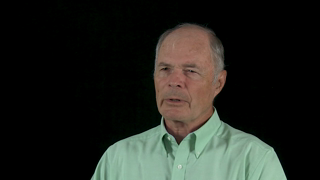4:50 | He received ground fire on his first combat mission. Dick Dyer was co-pilot in a Huey and he saw tracers for the first time which was a little unnerving. He felt sorry for the villagers caught in the battle, as he watched gunships blast away at the Viet Cong. Later, he noticed the pilot had let the engine RPM get much lower than he had been taught was safe. This was the beginning of a valuable lesson.
Keywords : Dick Dyer Vietnam helicopter pilot Iron Triangle Viet Cong (VC) Johnny Gay warrant officer tracer Bandits gunship

Dick Dyer was in college ROTC when he was offered the chance to learn to fly. The program was geared to a private pilot license but the instructor was a a World War II flying ace. This gave him an advantage when he was commissioned and sent to flight school to learn to fly helicopters.
After his initial aviation training, Dick Dyer was sent to Fort Rucker, where he learned to pilot Hueys, the Bell UH-1 helicopter used by the Army. He knew he was slated for Vietnam and he was prepared for that. What he was not prepared for was his father's reaction.
Dick Dyer and Jim Thorne were in flight school together and they both were deployed to Vietnam with the 145th Aviation Battalion flying Hueys. There was a great need for pilots and every one of them practically had a helicopter strapped on.
It was a forward element for purposes of quick reaction. Dick Dyer was part of a deployment of a few helicopters to a nearby rubber plantation without any additional security. That didn't last long. They went back to Bien Hoa air base, where the pilots and crew lived off base in an interesting arrangement.
In Vietnam, helicopter pilot Dick Dyer was reminded of what he was taught in ROTC, that you can't get too close to the enlisted men and non-commissioned officers. When he wasn't flying, he corresponded with his wife and family and even a few random citizens who got his name from the paper back home.
Helicopter pilot Dick Dyer was sent to pickup supplies from a ship in the Mekong Delta, but when he approached, the call sign and frequency he was given for contact elicited no reply. Circling the ship, he saw other helicopters land and take off so he went on in. Then he got an earful.
Asked to describe what happened on the mission when he was shot down, Dick Dyer has to ask, "Which one?" During the first incident, he had to land immediately, but everyone was OK. The second time, people were shot, but the aircraft was able to limp home.
During the Tet Offensive of 1968, Dick Dyer and other helicopter pilots and crew manned the berms with their personal weapons as the night lit up with fire of all kinds. The next day, there was a rush to transport many troops to new positions to respond to the widespread attacks.
The call went out. There was a unit in trouble and they needed casualties evacuated. Huey pilot Dick Dyer responded, but as he was taking off with the wounded, there was a loud boom. He settled back on the ground and then he heard from his crew chief. This helicopter wasn't going anywhere.
When he returned from his first tour in Vietnam, The Beatles' Hey Jude welcomed him home. Nobody else did. After a couple of years stateside, Dick Dyer returned to the embattled country, this time north of Da Nang. He felt that the command structure there was always putting him in a bad situation.
What was Operation Lam Son 719 like? To helicopter pilot Dick Dyer, it was a "gaggle." There were so many aircraft flying at once, it seemed to him like hundreds. A recurring problem on these big troop movements was overloading caused by eager soldiers. On occasion, the pilots were tasked with transporting reporters.
The veterans today have it easier than Dick Dyer did when he returned from Vietnam. The mood is supportive, and when he wears his Vietnam Veteran hat, he gets a little of the love he missed back in the day. He is very proud of the role that helicopter pilots like himself played in the war.